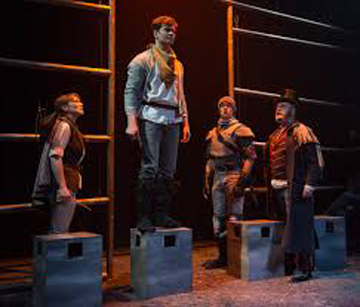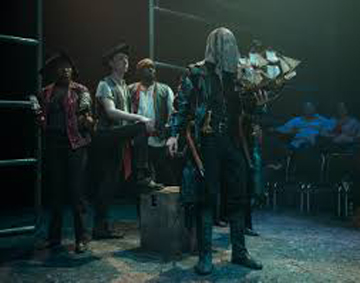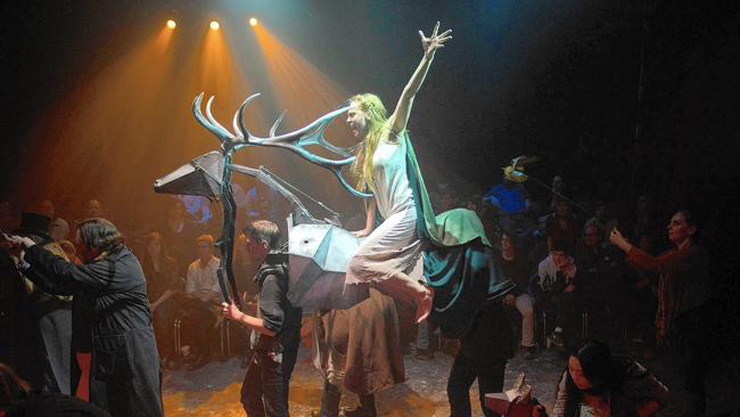
In the age of Netflix, Hulu, and Amazon Prime Video, where binge watching is not wholly unexpected (just one/two/ten more episode(s) before bed), what's a mere nine hours of spellbinding, raw theatrics? The House Theater of Chicago's Nathan Allen and Chris Mathew’s The Hammer Trinity, now at the Arsht Center, seemingly has it all. It is three plays that encourage the audience to settle into their seats for about nine hours, save a few breaks for snacks, dinner and interacting with the actors. There's a nice little stretching routine halfway through that is usually lead by one of the actors.
There are model planes, pirates, a human iron stag; there are gun shots, chase sequences, bombs, fog and flashes of light, a bit of Old West (and Old World) nostalgia, all set against a confined yet intimate setting that both draws the audience into the scene, and effectively keeps them out.
Juxtaposed by this Old World feeling, the cast brings youth and freshness. They are walking, fighting, jousting advertisements for Abercrombie & Fitch, refined yet casual, approachable yet sleek enough to command attention. Boots, jeans, and buttoned-down shirts are the staple. For the characters of the upper echelon, the booties are adorned with lace and frills, and a fine brocade outfit found deep in the trenches of a costume designer’s trunk, over the casual ware.
And the plot is certainly thought provoking, leaving the viewer with many questions long after the dragons have crept back into their lairs.
The question becomes, can you commit to ten hours without asking yourself if the characters' stories are important enough and compelling enough to keep you there?
Young, soft, and model-esque Casper Kent is the hero. He is the forbidden lovechild whose existence alone threatens to throw off the balance of "The Hand," a legion of five leaders that govern the republic. There are two storytellers: the magician, Hap the Golden, and the comically fearsome dragon, Irek Obsidian. Hap, a capable chess player, crafts a story where Casper is the only one who, like King Arthur himself, can lift the magical Hammer, thus uniting the land under a purported happily ever after, as the righteous heir to the throne. Irek orchestrates a competing story, one in which the responsibility of the republic is carried by a band of leaders.
Hap is ruthless in his delivery. "You’re special," he tells young Kent early in the first installment.
Kent, though smart, is an ingénue. Who wouldn’t believe the sneaking suspicion most have that we are, well,just a little different from the rest? You know a little smarter, better, braver, kinder, a bit more good looking, than the rest? Kent is not a victim; he is a willing participant in Hap's story, and thus our tale unfolds.
Patriarchy and matriarchy stand on opposing sides of the ring, one supporting the story of a male leader, and the other a young, barefoot naiveté: July of the 7 foxes (and Casper's love interest), who spins her own tale to save the day.

"Story save us all."
This is the phrase uttered by all the characters of The Hammer Trinity at some point or other, usually before or during some pivotal point in the convoluted plot. At first it's a phrase; then it's a chant. Before the audience can absorb the irony of antagonizing the rich “villain” who pushes for a republic instead of one tyrannical king, the phrase becomes so embedded in the psyche that it must be accepted.
It plays perfectly to the play’s theme, of free will versus pre-destination, of religion pitted against a godless nation, of a republic versus birthright kingship. How many times have we heard, “God save the queen!” or “God save us” or “Lord save us all?” The words are ritualistic. Certainly the title of the play isn’t a suggestion; it’s a commentary, suggesting something religious, spiritual and maybe even transcendental, about life itself.
And it’s important. The play wants you to believe it’s important. The storytellers beg viewers to become willing participants and believe a story that suggests something truthful about life. The nugget of truth cannot be denied, and it’s this: every person is responsible for his or her own destiny. While some of us may have been coddled in silken sheets in houses of gold, the rest of us, cradled in the arms of a loving and poor mother, are just as equally responsible in writing our stories as the bees are in pollinating the land. And all, for the greater good.
To be sure, there is no true precedence to a performance like The Hammer Trinity. It is comprised of three separate but undivided plays: The Iron Stag King, The Crownless King, and the concluding chapter, The Excelsior King.
The Arsht and Chicago's House Theater initially were determined to have viewers commit to the full three series show in one long day of binge watching, but recently in the run, they've accommodated those who'd rather see one of the plays individually.

Throughout the play, the audience is completely enraptured by the action, because there is plenty of it. Young romance, after all, is a beacon of hope for a better tomorrow; from it, a new story is woven. The characters suddenly become self-aware as the audience forgets themselves. Curiosity to know how the path of this tale fuels the viewer to wait a little longer, sit a little longer, because the point will surely be known.
That we must all sacrifice blood for the greater good. That there are opposing storylines, and sometimes it’s better to just write our own. That there is no true hero; we belong to ourselves. That there is no special and no ordinary; it’s just us. That violence repeats itself, though sometimes blood must be sacrificed for the greater good. That love is our only hope in a faceless society. That the character is more important than the story.
I cannot say that I loved the execution of The Hammer Trinity. Anachronistic elements diverted from the story (Kaelan Wayne's modern mansion vs. a hut in the middle of a forest where Kent grew up; Wayne and Kent's post modern suits versus shamanistic cloaks, and pirate gear donned by whiskey wielding crusty folk who man the seas; flying machines and refined weaponry for fighting dragons vs. bow and arrow archery; electricity vs. torches; a clear photograph of Kent hanging on the wall vs. the “photo contraption” seen early on in the play). "Where are we? When are we? How did we get here? '' These are not purposeful questions.
What I did embrace, however, is that long after the civil war ends, long after our hero lays down the magic hammer that as it turns out, anyone can lift (even a woman, as seen by Queen Rienne who is able to lift the hammer when she tries to get rid of it), long after the villains die, the story remains, and it’s yours for interpretation.
As the
story goes, we each write our own plot and with it, our very own
conclusions.
The Hammer Trinity from the House Theater of Chicago and the Arsht Center’s Theater Up Close series will perform at 1 p.m. Saturdays and Sunday through May 8 in the Carnival Studio Theater at the Arsht Center’s Ziff Ballet Opera House, 1300 Biscayne Boulevard, Miami. Tickets are $150 for all three, $55 for one show. Running time is about 9¾ hours. (305) 949-6722 or www.arshtcenter.org.
 MAIN MENU
MAIN MENU

